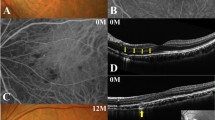Abstract
Purpose
On the basis of angiographic features, it is suggested that choroidal circulation disturbance may be involved in the pathogenesis of multiple evanescent white dot syndrome (MEWDS). The aim of this study is to quantitatively evaluate changes in choroidal circulation hemodynamics using laser speckle flowgraphy (LSFG) in patients with MEWDS.
Methods
Twelve eyes of 12 patients with MEWDS and 12 unaffected fellow eyes as controls were included. The macular mean blur rate (MBR), a quantitative index of relative blood flow velocity in the choroid, was measured by LSFG. Sequential changes in the average MBR values at the macula with granular changes and the lesion area with white dots were analysed. Moreover, correlations between the MRR changing rate and initial visual functions were examined.
Results
Visual functions significantly improved 3 months after initial visit with accompanying improvements in outer retinal morphology. When compared with the baseline measurements, the MBR significantly increased at the macula of the affected eyes by 20.2 % and 13.0 % at 1 and 3 months respectively (P < 0.01 for both), while no significant change was detected in fellow eyes. Similarly, the MBR increased at the lesion area by 17.8 % and 12.0 % at 1 and 3 months respectively (P < 0.05 for both). Notably, the macular MBR elevation at 1 month was negatively correlated with both initial best-corrected visual acuity and the average threshold at the macula on Humphrey perimetry at baseline (R = −0.76, P = 0.003; R = −0.60, P = 0.03, respectively), suggesting a close link between initially reduced choroidal blood flow and functional abnormalities at the onset of MEWDS.
Conclusions
These results, in concert with angiographic findings, are likely to reinforce the concept of choroidal circulation impairment as a predisposing factor for MEWDS.




Similar content being viewed by others
References
Jampol LM, Sieving PA, Pugh D, Fishman GA, Gilbert H (1984) Multiple evanescent white dot syndrome. I. Clinical findings. Arch Ophthalmol 102:671–674
Nguyen MH, Witkin AJ, Reichel E, Ko TH, Fujimoto JG, Schuman JS, Duker JS (2007) Microstructural abnormalities in MEWDS demonstrated by ultrahigh resolution optical coherence coherence tomography. Retina 27:414–418
Hangai M, Fujimoto M, Yoshimura N (2009) Features and function of multiple evanescent white dot syndrome. Arch Ophthalmol 127:1307–1313
Li D, Kishi S (2009) Restored photoreceptor outer segment damage in multiple evanescent white dot syndrome. Ophthalmology 116:762–770
Ie D, Glaser BM, Murphy RP, Gordon LW, Sjaarda RN, Thompson JT (1994) Indocyanine green angiography in multiple evanescent white dot syndrome. Am J Ophthalmol 117:7–12
Obana A, Kusumi M, Miki T (1996) Indocyanine green angiographic aspects of multiple evanescent white dot syndrome. Retina 16:97–104
Hirose S, Saito W, Yoshida K, Saito M, Dong Z, Namba K, Satoh H, Ohno S (2008) Elevated choroidal blood flow velocity during systemic corticosteroid therapy in Vogt–Koyanagi–Harada disease. Acta Ophthalmol 86:902–907
Aizawa N, Yokoyama Y, Chiba N, Omodaka K, Yasuda M, Otomo T, Nakamura M, Fuse N, Nakazawa T (2011) Reproducibility of retinal circulation measurements obtained using laser speckle flowgraphy-NAVI in patients with glaucoma. Clin Ophthalmol 5:1171–1176
Nagahara M, Tamaki Y, Tomidokoro A, Araie M (2011) In vivo measurement of blood velocity in human major retinal vessels using the laser speckle method. Invest Ophthalmol Vis Sci 52:87–92
Hashimoto Y, Saito W, Mori S, Saito M, Ishida S (2012) Increased macular choroidal blood flow velocity during systemic corticosteroid therapy in a patient with acute macular neuroretinopathy. Clin Ophthalmol 6:1645–1649
Saito M, Yoshida K, Saito W, Fujiya A, Ohgami K, Kitaichi N, Tsukahara H, Ishida S, Ohno S (2012) Astaxanthin increases choroidal blood flow velocity. Graefes Arch Clin Exp Ophthalmol 250:239–245
Saito M, Saito W, Hashimoto Y, Yoshizawa C, Fujiya A, Noda K, Ishida S (2013) Macular choroidal blood flow velocity decreases with regression of acute central serous chorioretinopathy. Br J Ophthalmol 97:775–780
Saito M, Saito W, Hashimoto Y, Yoshizawa C, Shinmei Y, Noda K, Ishida S (2013) Correlation between decreased choroidal blood flow velocity and the pathogenesis of acute zonal occult outer retinopathy. Clin Exp Ophthalmol 42:139–150
Tamaki Y, Araie M, Kawamoto E, Eguchi S, Fujii H (1994) Noncontact, two-dimensional measurement of retinal microcirculation using laser speckle phenomenon. Invest Ophthalmol Vis Sci 35:3825–3834
Isono H, Kishi S, Kimura Y, Hagiwara N, Konishi N, Fujii H (2003) Observation of choroidal circulation using index of erythrocytic velocity. Arch Ophthalmol 121:225–231
Sugiyama T, Araie M, Riva CE, Schmetterer L, Orgul S (2010) Use of laser speckle flowgraphy in ocular blood flow research. Acta Ophthalmol 88:723–729
Gass JD, Agarwal A, Scott IU (2002) Acute zonal occult outer retinopathy: a long-term follow-up study. Am J Ophthalmol 134:329–339
Hirooka K, Saito W, Hashimoto Y, Saito M, Ishida S (2014) Increased macular choroidal blood flow velocity and decreased choroidal thickness with regression of punctate inner choroidopathy. BMC Ophthalmol 14:73
Uy HS, Chan PS (2002) Multiple evanescent white dot syndrome. In: Foster CS, Vitale AT (eds) Diagnosis and treatment of uveitis. W. B. Saunders, Pennsylvania, pp 767–771
Riva CE, Titze P, Hero M, Petrig BL (1997) Effect of acute decreases of perfusion pressure on choroidal blood flow in humans. Invest Ophthalmol Vis Sci 38:1752–1760
Hashimoto Y, Saito W, Saito M, Hirooka K, Yoshizawa C, Noda K, Ishida S (2014) Retinal outer layer thickness increases with regression of multiple evanescent white dot syndrome and visual improvement positively correlates with photoreceptor outer segment length. Acta Ophthalmol in press. doi: 10.1111/aos.12413
Riva CE, Cranstoun SD, Grunwald JE, Petrig BL (1994) Choroidal blood flow in the foveal region of the human ocular fundus. Invest Ophthalmol Vis Sci 35:4273–4281
Acknowledgments
Conflicts of Interest
None.
Financial Disclosures
None.
Author information
Authors and Affiliations
Corresponding author
Rights and permissions
About this article
Cite this article
Hashimoto, Y., Saito, W., Saito, M. et al. Decreased choroidal blood flow velocity in the pathogenesis of multiple evanescent white dot syndrome. Graefes Arch Clin Exp Ophthalmol 253, 1457–1464 (2015). https://doi.org/10.1007/s00417-014-2831-z
Received:
Revised:
Accepted:
Published:
Issue Date:
DOI: https://doi.org/10.1007/s00417-014-2831-z




